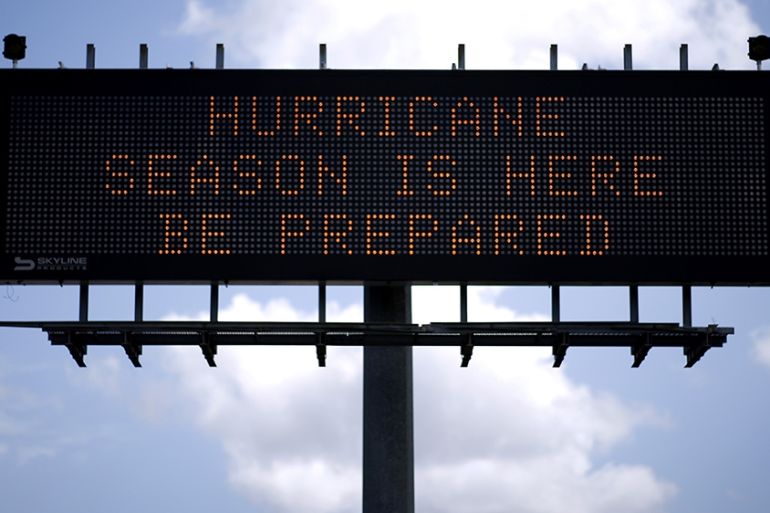‘Near-normal’ Atlantic hurricane forecast offers little comfort
Up to 15 storms are predicted – and that could cause billions in damage.

The Atlantic hurricane season in the summer of 2019 will be “near normal,” with nine to 15 named storms occurring from June 1 through November 30, according to the United States government agency that tracks weather patterns.
In its annual report, the National Oceanic and Atmospheric Administration (NOAA) predicts that as many as eight of those storms will become hurricanes, with winds reaching at least 74 miles an hour. The forecast, which will be updated later in the season, now says up to four storms could become Category 3, 4 or 5 hurricanes, with winds surging to more than 110 miles an hour.
Keep reading
list of 4 itemsBrazilian horse ‘Caramelo’ rescued after being trapped on roof by floods
Brazil flooding death toll hits 100 as government pledges aid
The Final Breath
The opposing forces of the El Nino warming phenomenon in the Pacific Ocean and higher-than-normal surface temperatures in parts of the North Atlantic will determine the intensity and frequency of the storm season, said Neil Jacobs, acting NOAA administrator. The enhanced African monsoon, which can set off storms in the Atlantic, will be another factor.
“It only takes one,” said Daniel Kaniewski, deputy director for resilience at the Federal Emergency Management Agency. “It only takes one land-falling hurricane to cause great damage to a community.”
Economic Impact
In a broader look at the hit to business, commerce and people’s livelihoods, NOAA calculated the 2017 economic impact of Hurricanes Maria and Irma at $117bn, with most of the damage and expense concentrated in Florida, Puerto Rico and the US Virgin Islands
In Texas, Hurricane Harvey’s impact was estimated at $3.8bn a year after the 2018 storm, according to the Texas Comptroller of Public Accounts.
All told, the damage from storms in 2018 – less severe than that in 2017 – was estimated at $50m.
Predicting damage’s cost
Commerce Secretary Wilbur Ross, who joined weather officials as they made their announcement about the 2019 summer forecast, said storm damage is unpredictable because there’s no way to tell in advance whether a storm will hit land. This remains a major concern every year.
“As a Florida resident, I’m acutely aware of the tremendous impact that hurricanes can have on lives, property and businesses,” said Ross, who owns a $23m mansion in Palm Beach that is only 4.3 feet above sea level.
Less acute was any acknowledgment that climate change could be affecting the severity of each successive season, said Astrid Caldas, senior climate scientist at the Union of Concerned Scientists.
“Certainly, global warming has a hand in those sea-surface temperatures,” she said. “And we have seen in the last two years that hurricanes have intensified at breakneck speed. That is unusual.”
She also said predictions – whether from NOAA or Colorado State University’s department of atmospheric science – are more about probability than precision.
“I’d highlight the fact that historically, we’ve had some of the most damaging hurricanes in years that were projected to have low activity,” she said, noting that forecasters can not say “we are off the hook” with a “near-normal outlook.”
In areas most vulnerable to storms, such as Ocracoke Island in North Carolina’s Outer Banks, the agency forecast didn’t faze Stew Pidasso, who works at Zillie’s Island Pantry, a wine and beer bar.
“We’re pretty on top of it, since it does affect our summer,” he says. “In the past, we had a few homes flooded by Matthew [in 2016], but that’s the worst we’ve had in a few years.”
Kaniewski emphasized advance preparation, telling people in hurricane zones to stock up enough supplies to last for a 72-hour interval, keeping stores of clothing, food, and medication in a safe, accessible place, along with a little ready cash. He also urged those affected to plan their evacuation routes, keep battery-powered radios on hand, download apps from the Federal Emergency Management Agency, and listen to local officials in the event of a storm.
Phil Klotzbach, a research scientist at Colorado State University, said NOAA’s outlook was close to his group’s own.
Weaker-than-normal El Nino conditions, which increase upper-level westerly winds that disperse hurricanes, will be a major factor in keeping storm numbers down, he said. But even the most accurate weather-pattern modeling can’t predict where – or even if – storms will inflict damage on land.
“The number of land-falling hurricanes has not gone up,” he said. “If you look at damage by hurricanes, though, that’s going up dramatically.”
That’s hardly news to Ruth Paris, who works at a car-rental company on the tiny island of Vieques, just east of Puerto Rico. Hurricane Maria raked the US territory and devastated Puerto Rico and its outlying islands. The storm left Vieques off the electrical grid that was restored elsewhere in Puerto Rico for more than a year after the hurricane hit.
Paris retains vivid, unhappy memories of enduring a two-week stretch with no electricity and sparse essential supplies before relief workers reached the small island.
“It was very difficult to find food and water, and we were not prepared,” she said. “After Maria, we are always going to be afraid when hurricane season comes.”